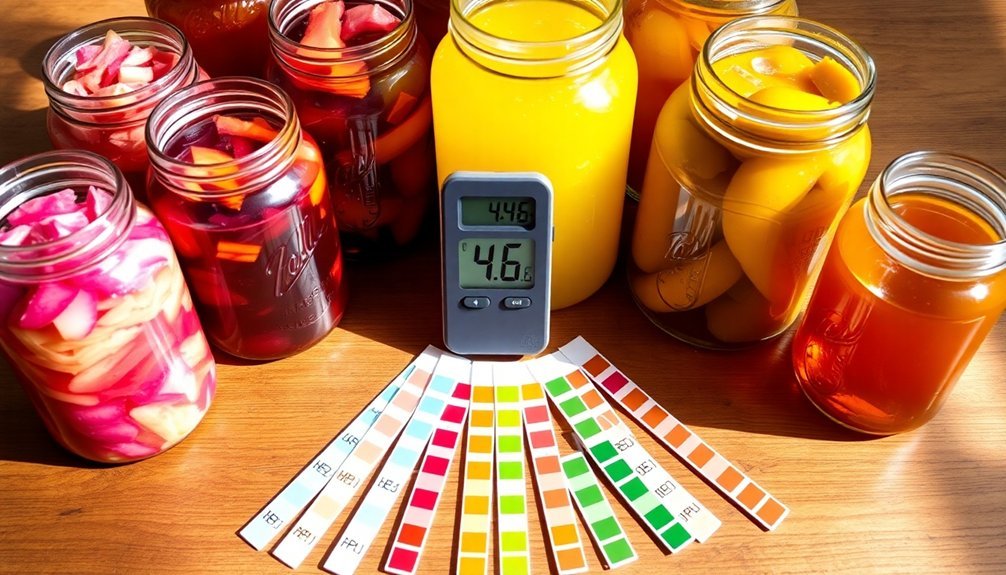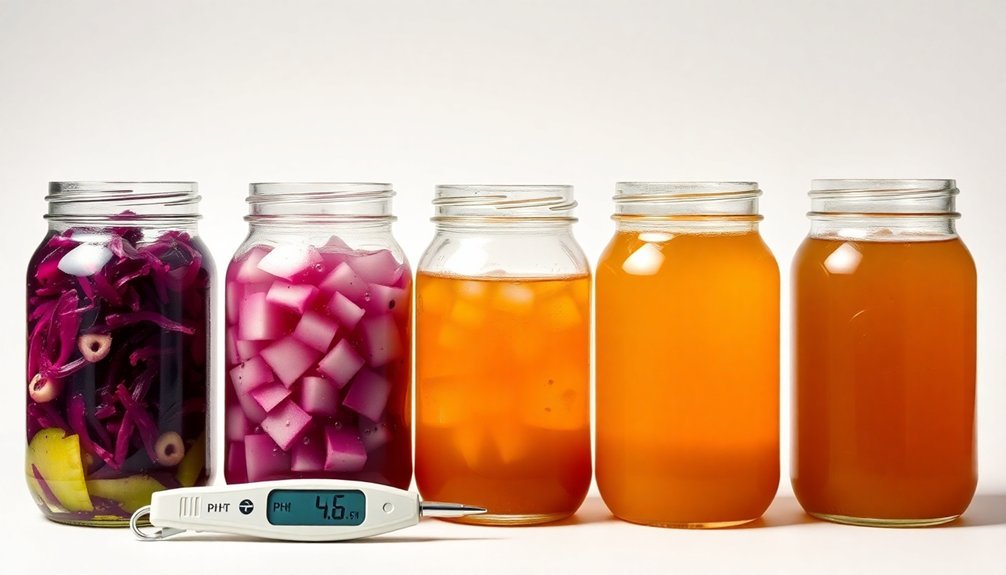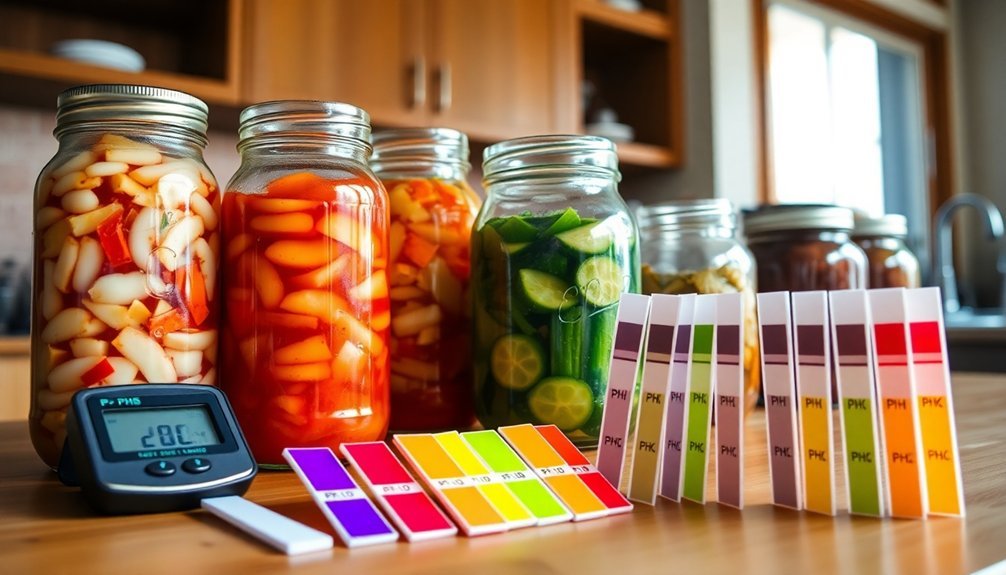Maintaining proper pH levels is essential for safe home fermentation. You'll need to keep your fermented foods at or below pH 4.6 to prevent harmful bacteria growth, particularly Clostridium botulinum. Use either digital pH meters for accuracy (±0.1 pH) or pH test strips for quick checks. Keep your fermentation temperature between 18-24°C (65-75°F) for ideal acid production, and monitor pH levels daily using clean equipment. Store your ferments in glass or food-grade plastic containers with proper weights to keep ingredients submerged. Following these pH guidelines and testing methods will help you create safe, delicious fermented foods. The journey to mastering fermentation safety is just beginning.
Understanding Ph in Food Safety

Safety in fermentation begins with understanding pH, the measure of acidity that ranges from 0 to 14 on the pH scale. When you're fermenting foods at home, you'll need to pay close attention to pH levels, as they're vital for preventing harmful bacteria growth and ensuring your ferments are safe to consume.
The magic number you need to remember is 4.6. This pH value is critical because it prevents Clostridium botulinum, the bacteria that causes botulism, from producing toxins. Most harmful bacteria can't thrive in acidic environments below this level, which is why proper fermentation is so effective at food preservation. Alternative preservation methods like irradiation and microwave sterilization can also be used for food safety.
You'll want to classify your fermented foods into three categories: acid foods (pH ≤ 4.6), acidified foods (low-acid foods with added acid to reach pH ≤ 4.6), and low-acid foods (pH > 4.6).
To monitor your fermentation's progress, you'll need to use either pH test strips or a digital pH meter. Make sure you're taking accurate measurements by blending your samples to a uniform consistency and testing them at room temperature (25°C).
Regular pH monitoring isn't just good practice – it's essential for your safety.
Essential Ph Testing Equipment
Once you understand pH's role in food safety, you'll need the right tools to monitor your ferments effectively. Digital pH meters and test strips are your two main options, each with distinct advantages for home fermentation.
Digital pH meters offer superior accuracy with readings within ±0.1 pH at 25°C and resolution as precise as 0.01 pH. They're ideal for serious fermenters who need exact measurements. Most models feature automatic temperature correction, multi-point calibration, and waterproof designs. The 300-hour battery life makes digital meters reliable for long-term use.
You'll need to maintain them properly with calibration solutions and electrode storage solution to prevent drying.
Test strips provide a budget-friendly alternative that's perfect for quick checks. While they're less accurate and can be subjective due to color interpretation, they don't require batteries or maintenance. They're particularly useful for testing brine in vegetable ferments and kombucha.
For digital pH meters, you'll need calibration solutions (typically pH 4.00, 6.86, and 9.18) to guarantee accuracy. These solutions are essential for proper calibration and reliable readings.
Choose your equipment based on your fermentation needs – digital meters for precision work, or test strips for basic monitoring.
Optimal Ph Ranges

Three essential pH ranges define successful fermentation: the safety threshold of 4.6, the perfect range for flavor development, and the starting range that kickstarts fermentation.
The optimal temperature range of 18-24°C (65-75°F) provides ideal conditions for fermentation success.
You'll need to guarantee your ferments drop below pH 4.6 to prevent harmful bacteria like E. coli, Salmonella, and most importantly, Clostridium botulinum from surviving.
For peak flavor and texture development, you'll want to monitor how quickly your ferment reaches its target pH. Your lactic acid bacteria work best within specific ranges, breaking down carbohydrates and proteins to create complex flavors and desired textures.
If the pH stays too high, you'll end up with soft, slimy vegetables instead of the crisp, tangy results you're aiming for.
Several factors affect how quickly you'll reach these ideal ranges. Salt concentration, sugar content, and oxygen exposure all play essential roles.
You'll need to keep your vegetables fully submerged and use clean equipment to prevent unwanted microbes from interfering with the pH decline.
Using an accurate pH meter or test strips, check your ferment's progress regularly and document the readings to track your success.
Temperature Effects on Ph
Temperature stands as one of the most powerful influences on your ferment's pH development. When you maintain temperatures between 60-70°F (16-21°C), you'll achieve the ideal balance of acid production and bacterial growth, leading to consistent pH drops that create safe, flavorful ferments.
Higher temperatures accelerate acid production, causing pH to drop too quickly. While this might seem beneficial, it actually creates problems:
- Rapid acidification leads to mushy textures and sharp flavors
- Beneficial bacteria get overwhelmed by acid-producing strains
- Your ferment becomes more susceptible to yeast spoilage
Cooler temperatures below 58°F (14°C) greatly slow down acid production, which can be dangerous for your ferments. You'll notice that pH doesn't drop quickly enough to create the protective acidic environment needed to prevent harmful bacteria growth.
This slower acid development also affects how enzymes function during fermentation, potentially leading to incomplete sugar conversion and inadequate preservation.
To maintain proper pH development, you'll need to monitor your fermentation temperature actively. Consider using a temperature-controlled environment like a basement or dedicated fermentation chamber, especially if you live in an area with variable temperatures.
Monitoring Ph During Fermentation

You'll need a digital pH meter or pH test strips to accurately monitor your fermented foods' acidity levels.
Take daily pH readings by inserting your meter into the liquid portion of your ferment or using test strips to check the brine.
Track your readings to guarantee the pH drops below 4.6 for safety, paying special attention during the first few days when the most dramatic changes occur.
Ph Testing Equipment Basics
During the fermentation process, monitoring pH levels is essential for both safety and success. You'll need reliable pH testing equipment to guarantee your fermented foods maintain proper acidity levels below 4.6, which prevents harmful pathogens from developing.
Digital pH meters offer the most accurate and precise measurements, with many models featuring automatic calibration and temperature compensation. While pH test strips are more affordable and convenient, they're less accurate and can be affected by food coloring. For home fermentation, consider investing in a pocket-sized meter that combines portability with reliable performance.
When choosing pH testing equipment, look for these essential features:
- Automatic temperature compensation to guarantee accurate readings across different temperatures
- Waterproof design to withstand various fermentation environments
- Replaceable electrodes for cost-effective maintenance
To maintain your pH meter's accuracy, you'll need to handle it with care. Clean the probe using only water, store it properly with the protective cap on, and calibrate it regularly using pH calibration solutions.
With proper maintenance, your pH meter will provide reliable readings for hundreds of hours of use, helping you monitor your fermentations effectively.
Daily Ph Reading Methods
Monitoring pH levels throughout your fermentation process requires consistent and accurate readings to secure both safety and success. You'll need to choose between using a digital pH meter for precise measurements or pH test strips for quick checks, though meters provide superior accuracy to at least one decimal point.
| Testing Method | When to Use | Key Points |
|---|---|---|
| Digital pH Meter | Critical measurements, dairy ferments | Calibrate regularly, use distilled water |
| pH Test Strips | Quick spot checks, vegetable ferments | Compare to color chart, less precise |
| Direct Probe Testing | Low brine situations, thick ferments | Use specialized probes, clean thoroughly |
For most fermentations, you'll want to take readings at the start to verify proper conditions, during the middle to track progress, and at completion to confirm desired pH levels. When fermenting dairy products, ascertain the pH drops to 4.6 or below within 48 hours. For vegetable ferments, monitor the brine pH regularly, and if you're working with alcoholic fermentations, maintain pH between 2.5 and 4. Remember to clean your testing equipment thoroughly between readings and recalibrate your digital meter periodically using pH powder packets and distilled water.
Tracking Ph Safety Levels
Safety in fermentation hinges on maintaining proper pH levels, with 4.6 being the vital threshold that prevents harmful bacteria from thriving.
You'll need to monitor your fermentation's pH regularly to guarantee it drops below this vital point within the required timeframe.
For room temperature fermentations (20-22°C), check your pH every 12 hours until it reaches 4.6 or lower within 48 hours.
If you're fermenting in refrigerated conditions, test daily until reaching 4.6 within 4 days.
You should discard any batch that doesn't meet these timeframes.
To maintain safe fermentation practices:
- Record pH readings and fermentation times in a log for future reference
- Use a controlled environment to maintain consistent temperature
- Monitor more frequently during room temperature fermentation than cold fermentation
Different products have specific safety requirements.
For dairy ferments, you must reach pH 4.6 within 48 hours.
Non-pasteurized fermented vegetables need pH 4.4 or lower when refrigerated, while heat-pasteurized products are shelf-stable at pH 4.6.
Remember that temperature directly affects how quickly pH drops, so maintaining proper temperature throughout fermentation is vital for safety.
Fermentation Containers and Ph Control
Your choice of fermentation container material directly affects the pH stability and overall success of your fermented foods, with glass and food-grade plastic being the safest options to prevent contamination.
You'll need to monitor pH levels regularly using either pH strips or a digital meter to guarantee your fermentation stays within the ideal range, typically between 3.5 and 4.6 for most vegetable ferments.
To maintain proper pH control, you should keep your ingredients submerged beneath the brine using fermentation weights and make sure your container has an airtight seal to create the right anaerobic environment.
Container Material Impact
The material of your fermentation container plays an essential role in determining both the rate of fermentation and pH changes during the process. If you're aiming for quick fermentation, plastic containers will give you the fastest results, while porcelain vessels provide a slower, more gradual process. Glass containers offer a middle-ground option, reaching similar pH levels as plastic by the fourth day of fermentation.
Your choice of container material will greatly affect the chemical composition of your fermented foods. Here's what you'll notice with different materials:
- Plastic containers promote higher lactic acid production and result in more butyric acid by day 12.
- Porcelain vessels encourage more volatile compounds, enhancing flavor and aroma profiles.
- Glass containers provide balanced fermentation with pH levels reaching 3.5 by day 4.
While container material influences fermentation rates and chemical compounds, it won't greatly impact the microbial structure of your ferment. Lactobacillus remains the dominant bacteria regardless of your container choice.
However, you'll find that porcelain containers show higher nitrite levels early in the fermentation process, while plastic containers tend to produce more threonine and lactic acid throughout the fermentation period.
Ph Monitoring Methods
Maintaining precise pH levels stands as one of the most critical aspects of successful fermentation, requiring both proper equipment and consistent monitoring techniques.
You'll need a digital pH meter with automatic temperature compensation for accurate readings, and you should calibrate it using standard buffer solutions before each testing session.
When you're ready to test, verify your fermented vegetables are at room temperature, and extract enough brine to submerge the pH meter's probe completely.
Take readings from multiple spots in the container, as pH levels can vary throughout. You'll want to document at least three readings from different areas, recording dates and times for your reference.
For ideal food safety, you'll need to achieve a pH of 4.6 or lower, with 4.1 being perfect for maximum protection against harmful bacteria.
Keep your fermentation temperature between 60°F and 72°F, and monitor pH levels every 12 hours during room temperature fermentation.
While pH strips can serve as a backup method, they're less reliable than a proper pH meter.
Remember to clean your probe with distilled water between readings to maintain accuracy and prevent cross-contamination.
Frequently Asked Questions
Can I Save and Reuse Brine From Successful Ferments for Future Batches?
Yes, you can reuse brine from successful ferments! Store it in a clean glass jar in your fridge for up to six months. Just use 1/4 cup in new veggie ferments to kickstart fermentation with beneficial bacteria.
How Long Should I Wait Before Testing Ph After Adding Salt?
You should wait at least 24 hours after adding salt before testing pH. This allows time for the brine to reach equilibrium and the initial fermentation process to begin properly.
Does Artificial Lighting Affect Fermentation Ph Levels During Storage?
No, artificial lighting won't directly affect your fermentation's pH levels during storage. While you should store ferments in dark places, this is mainly to prevent spoilage rather than to maintain pH levels.
Should Ph Readings Be Taken From Top, Middle, or Bottom of Ferment?
You should take pH readings from the middle of your ferment. It provides the most representative sample and stable environment, while avoiding surface contamination risks from the top and settled solids at the bottom.
Can Metal Utensils Temporarily Alter Ph Readings When Testing Fermented Foods?
Yes, metal utensils can temporarily alter your pH readings. You'll want to avoid using them when testing ferments, as they can react with acidic environments and give you inaccurate results.
In Summary
You've now got the essential knowledge to safely monitor and control pH in your home fermentation projects. By maintaining proper pH levels and using the right equipment, you'll create delicious fermented foods while preventing harmful bacteria growth. Remember that temperature plays a vital role, so keep tracking those pH levels throughout the process. With practice and careful monitoring, you'll master the art of safe home fermentation.





Leave a Reply